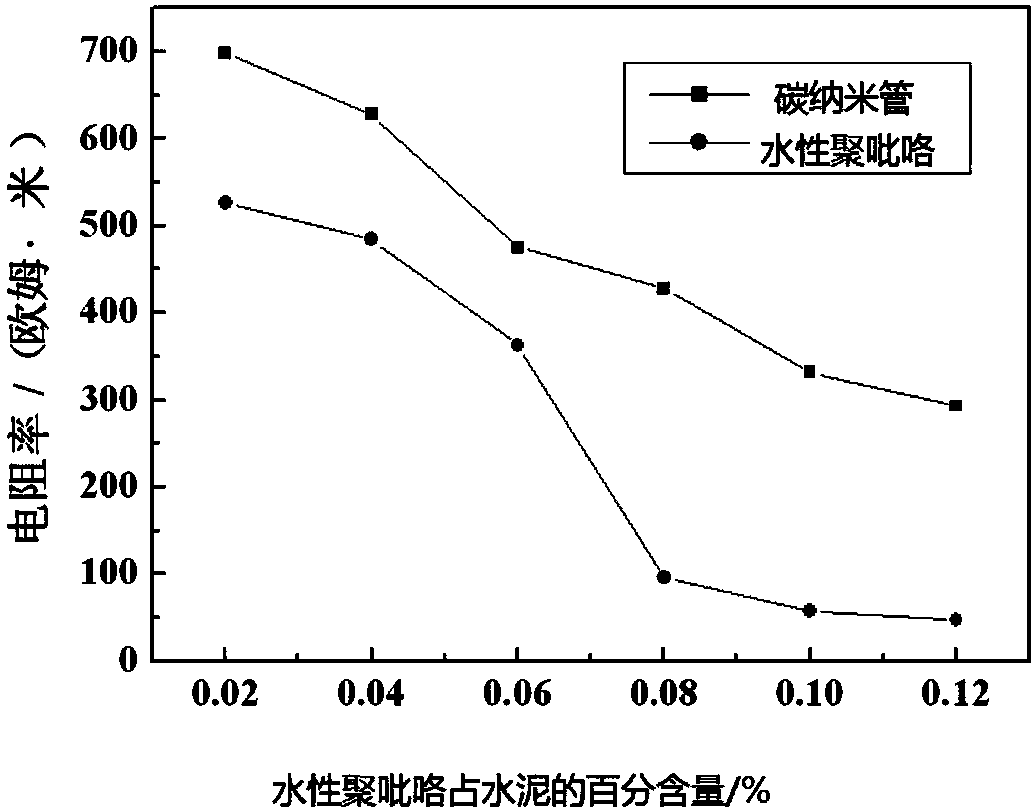Waterborne polypyrrole cement-based conductive composite material, preparation method and application
A conductive composite material, polypyrrole technology, applied in conductive materials, conductive materials, conductors and other directions, can solve the problems of inability to improve the conductive properties of composite materials, reduce mechanical properties, etc., achieve good pressure-sensitive properties and electrical-thermal properties, improve The effect of electrical conductivity and durability
- Summary
- Abstract
- Description
- Claims
- Application Information
AI Technical Summary
Problems solved by technology
Method used
Image
Examples
preparation example Construction
[0024] Another embodiment of the present invention provides a preparation method of water-based polypyrrole cement-based conductive composite material, comprising the following steps: (1) get the purified pyrrole monomer and place it in a round-bottomed flask, add an aqueous solution of sodium lignosulfonate, ice Under the condition of stirring in a water bath, FeCl was added dropwise 3 Aqueous solution, reacted for 8-12 hours under stirring conditions at room temperature, and made water-based polypyrrole polymer through suction filtration, drying, and grinding; (2) dissolving the water-based polypyrrole polymer prepared in step (1) in distilled water, adding Put it into a clean paddle mixer containing Portland 425 cement, stir at a slow speed for 120 seconds, then pause for 15 seconds and turn to medium and high speed for 120 seconds; (3) pour the stirred cement-based composite material into the mold, and vibrate , steam curing process, made of water-based polypyrrole cement-...
Embodiment 1
[0031] (1) Take 0.5mL of purified pyrrole monomer and place it in a 250mL round bottom flask, add 5mL of 1mol / L sodium lignosulfonate aqueous solution, and add 1mol / L of FeCl dropwise under the condition of stirring in an ice-water bath 3 5mL of aqueous solution, reacted at room temperature for 8 hours, then filtered, dried, and ground to make water-based polypyrrole polymer;
[0032] (2) Dissolve the water-based polypyrrole polymer prepared in step (1) in 10mL of distilled water, add it to a clean paddle mixer containing 1300g of Portland 425 cement, stir at a slow speed for 120 seconds, then pause for 15 seconds and turn to Stir at medium and high speed for 120 seconds;
[0033] (3) Pouring the stirred cement-based composite material into a mould, and undergoing vibration and steam curing processes to make a water-based polypyrrole cement-based conductive composite material.
Embodiment 2
[0035](1) Take 1 mL of purified pyrrole monomer and place it in a 250 mL round bottom flask, add 5 mL of 1 mol / L sodium lignosulfonate aqueous solution, and add 1 mol / L of FeCl dropwise under the condition of stirring in an ice-water bath 3 5mL of aqueous solution, reacted at room temperature for 8 hours, then filtered, dried, and ground to make water-based polypyrrole polymer;
[0036] (2) Dissolve the water-based polypyrrole polymer prepared in step (1) in 10mL of distilled water, add it to a clean paddle mixer containing 1300g of Portland 425 cement, stir at a slow speed for 120 seconds, then pause for 15 seconds and turn to Stir at medium and high speed for 120 seconds;
[0037] (3) Pouring the stirred cement-based composite material into a mould, and undergoing vibration and steam curing processes to make a water-based polypyrrole cement-based conductive composite material.
PUM
 Login to View More
Login to View More Abstract
Description
Claims
Application Information
 Login to View More
Login to View More - R&D Engineer
- R&D Manager
- IP Professional
- Industry Leading Data Capabilities
- Powerful AI technology
- Patent DNA Extraction
Browse by: Latest US Patents, China's latest patents, Technical Efficacy Thesaurus, Application Domain, Technology Topic, Popular Technical Reports.
© 2024 PatSnap. All rights reserved.Legal|Privacy policy|Modern Slavery Act Transparency Statement|Sitemap|About US| Contact US: help@patsnap.com









